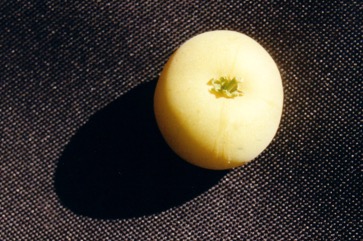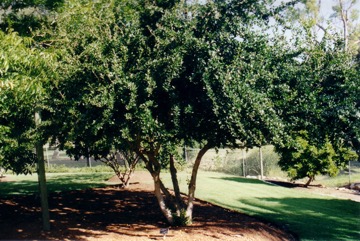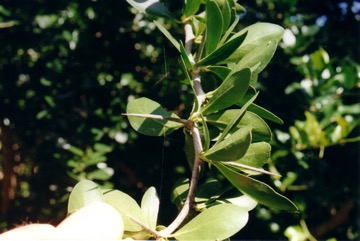Key apple

It is native to S and E Africa. It is subtropical. It can withstand drought but cannot tolerate frosts. They grow naturally in areas with temperatures in the range 14-22°C. Often they grow between 800 and 1200 m altitude but grow up to 2450 m altitude in Kenya. The rainfall where it grows naturally is 1000-1700 mm per year. It needs well drained soils. It is often on termite mounds. It can grow in arid places. It suits hardiness zones 9-10.
Also known as:
Amaqogolo, Dingaan’s apple, Emerogi, Kai, Kaiyaba, Kau, Kei apple, Mahlono, Manzana de kei, Mdovialisi, Mohlono, Mukokolo, Munhungura, Musvisvirondo, Mutumotote, Nhunguru, Ntapane, Pohon gulo gumantung, Prune caffre, Sangongongo, Umkokolo, Umkolo, Umqakalo, Umqokolo
Synonyms
- Aberia caffra (Hook. f. & Harv.) Hook.f.
Edible Portion
- Fruit
Where does Key apple grow?
Found in: Africa, Albania, Asia, Australia, Botswana, Brazil, Britain, Central America, Cuba, Djibouti, East Africa, Egypt, Eritrea, Eswatini, Ethiopia, Greece, India, Indonesia, Iran, Iraq, Israel, Italy, Kenya, Lesotho, Malawi, Malta, Mozambique, Namibia, North Africa, North America, Pacific, Philippines, Portugal, SE Asia, Slovenia, South Africa, Southern Africa, South America, Spain, St Helena, Sudan, Swaziland, Tanzania, Uganda, United States, West Indies, Zambia, Zimbabwe
Notes: The fruit are rich in Vitamin C. There are about 22 Dovyalis species. Also put in the Flacourtiaceae family.
Status: A popular fruit.
Growing Key apple
Cultivation: Plants are grown from seed. Seed are collected from fruit. The ripe fruit are cracked and allowed to rot for one week before removing the seed. There are about 20 seeds in each fruit. The seeds should be sown immediately in a nursery bed. Seedlings come through the soil in 12 days. When bushes are established they need to have their crown thinned out to allow more fruit to be produced. The trees can be used as a fence or hedge. Trees can be grown from cuttings, air layering and grafting. It can be grown as a hedge.
Edible Uses: The fruit are eaten fresh and used in jams and desserts. The fruit are acidic. Because the fruit are high in pectins they can be added in small amounts to help jams to jell and set. The green fruit are also pickled.
Production: Trees produce fruit in 5-6 years from seed and 2-3 years from cuttings. Fruit need to be fully ripe when harvested. Fruit can be harvested after they fall. Fruit mature in 90 days.
Nutrition Info
per 100g edible portion| Edible Part | Energy (kcal) | Protein (g) | Iron (mg) | Vitamin A (ug) | Vitamin c (mg) | Zinc (mg) | % Water |
|---|---|---|---|---|---|---|---|
| Fruit | 57 | 0.4 | 0.1 | - | 117 | - | 85.9 |
Key apple Photos



References
Ambasta, S.P. (Ed.), 2000, The Useful Plants of India. CSIR India. p 182
Arora, R. K., 2014, Diversity in Underutilized Plant Species - An Asia-Pacific Perspective. Bioversity International. p 68
Awodoyin, R.O., Olubode, O.S., Ogbu, J.U., Balogun, R.B., Nwawuisi, J.U. and Orji, K.O., 2015, Indigenous Fruit Trees of Tropical Africa: Status, Opportunity for Development and Biodiversity Management. Agricultural Sciences, 6, 31-41
Barwick, M., 2004, Tropical and Subtropical Trees. A Worldwide Encyclopedic Guide. Thames and Hudson p 156
Bodkin, F., 1991, Encyclopedia Botanica. Cornstalk publishing, p 357
Burkill, I.H., 1966, A Dictionary of the Economic Products of the Malay Peninsula. Ministry of Agriculture and Cooperatives, Kuala Lumpur, Malaysia. Vol 1 (A-H) p 870
Cundall, P., (ed.), 2004, Gardening Australia: flora: the gardener's bible. ABC Books. p 511
Cunningham, 1985,
Darley, J.J., 1993, Know and Enjoy Tropical Fruit. P & S Publishers. p 131
Dharani, N., 2002, Field Guide to common Trees & Shrubs of East Africa. Struik. p 224
H. G. A. Engler & K. A. E. Prantl, Nat. Pflanzenfam. 3(6a):44. 1893
Etherington, K., & Imwold, D., (Eds), 2001, Botanica's Trees & Shrubs. The illustrated A-Z of over 8500 trees and shrubs. Random House, Australia. p 267
Facciola, S., 1998, Cornucopia 2: a Source Book of Edible Plants. Kampong Publications, p 116
FAO, 1988, Traditional Food Plants, FAO Food and Nutrition Paper 42. FAO Rome p 257
Flowerdew, B., 2000, Complete Fruit Book. Kyle Cathie Ltd., London. p 162
Fox, F. W. & Young, M. E. N., 1982, Food from the Veld. Delta Books. p 228
Hedrick, U.P., 1919, (Ed.), Sturtevant's edible plants of the world. p 17 (As Aberia caffra)
HELY-HUTCHINSON,
Hibbert, M., 2002, The Aussie Plant Finder 2002, Florilegium. p 89
INFOODS:FAO/INFOODS Databases
Jardin, C., 1970, List of Foods Used In Africa, FAO Nutrition Information Document Series No 2.p 133
Joffe, P., 2007, Creative Gardening with Indigenous Plants. A South African Guide. Briza. p 222
John, L., & Stevenson, V., 1979, The Complete Book of Fruit. Angus & Robertson p 292
Katende, A.B., Birnie, A & Tengnas B., 1995, Useful Trees and Shrubs for Uganda. Identification, Propagation and Management for Agricultural and Pastoral Communities. Technical handbook No 10. Regional Soil Conservation Unit, Nairobi, Kenya. p 248
Kiple, K.F. & Ornelas, K.C., (eds), 2000, The Cambridge World History of Food. CUP p 1795
Long, C., 2005, Swaziland's Flora - siSwati names and Uses http://www.sntc.org.sz/flora/
Lord, E.E., & Willis, J.H., 1999, Shrubs and Trees for Australian gardens. Lothian. p 225
Lorenzi, H., Bacher, L., Lacerda, M. & Sartori, S., 2006, Brazilian Fruits & Cultivated Exotics. Sao Paulo, Instituto Plantarum de Estuados da Flora Ltda. p 601
Lyle, S., 2006, Discovering fruit and nuts. Land Links. p 186
Macmillan, H.F. (Revised Barlow, H.S., et al) 1991, Tropical Planting and Gardening. Sixth edition. Malayan Nature Society. Kuala Lumpur. p 314
Makonda, F. B. S., & Ruffo, C. K., 2011, Species List. NAFORMA, Tanzania
Martin, F. W., et al, 1987, Perennial Edible Fruits of the Tropics. USDA Handbook 642 p 28
Mbuya, L.P., Msanga, H.P., Ruffo, C.K., Birnie, A & Tengnas, B., 1994, Useful Trees and Shrubs for Tanzania. Regional Soil Conservation Unit. Technical Handbook No 6. p 240
Miguel, E., et al, 1989, A checklist of the cultivated plants of Cuba. Kulturpflanze 37. 1989, 211-357
Molla, A., Ethiopian Plant Names. http://www.ethiopic.com/aplants.htm
Morton, J. F., 1987, Fruits of Warm Climates. Wipf & Stock Publishers p 315
Palgrave, K.C., 1996, Trees of Southern Africa. Struik Publishers. p 636
Palmer, E and Pitman, N., 1972, Trees of Southern Africa. Vol. 3. A.A. Balkema, Cape Town p 1562
Peters, C. R., O'Brien, E. M., and Drummond, R.B., 1992, Edible Wild plants of Sub-saharan Africa. Kew. p 114
Plowes, N. J. & Taylor, F. W., 1997, The Processing of Indigenous Fruits and other Wildfoods of Southern Africa. in Smartt, L. & Haq. (Eds) Domestication, Production and Utilization of New Crops. ICUC p 190
Recher, P, 2001, Fruit Spirit Botanical Gardens Plant Index. www.nrg.com.au/~recher/ seedlist.html p 2
Royal Botanic Gardens, Kew (1999). Survey of Economic Plants for Arid and Semi-Arid Lands (SEPASAL) database. Published on the Internet; http://www.rbgkew.org.uk/ceb/sepasal/internet [Accessed 16th April 2011]
Ruiters-Welcome, A. K., 2019, Food plants of southern Africa. Ph.D. thesis. Univ. of Johannesburg p 99
Schmidt, E., Lotter, M., & McCleland, W., 2007, Trees and shrubs of Mpumalanga and Kruger National Park. Jacana Media p 430
Shava, S., 2000, The Use of Indigenous Plants as Food by a Rural Community in the Eastern Cape: an Educational Exploration. Masters Thesis Rhodes University. p 63
Sukarya, D. G., (Ed.) 2013, 3,500 Plant Species of the Botanic Gardens of Indonesia. LIPI p 247
Swaziland's Flora Database http://www.sntc.org.sz/flora
Tredgold, M.H., 1986, Food Plants of Zimbabwe. Mambo Press. p 99
UPHOF
USDA, ARS, National Genetic Resources Program. Germplasm Resources Information Network - (GRIN). [Online Database] National Germplasm Resources Laboratory, Beltsville, Maryland. Available: www.ars-grin.gov/cgi-bin/npgs/html/econ.pl (10 April 2000)
van Wyk, B, van Wyk, P, and van Wyk B., 2000, Photographic guide to Trees of Southern Africa. Briza. p 123
van Wyk, B., 2005, Food Plants of the World. An illustrated guide. Timber press. p 181
van Wyk, Be., & Gericke, N., 2007, People's plants. A Guide to Useful Plants of Southern Africa. Briza. p 42
van Wyk, B-E., 2011, The potential of South African plants in the development of new food and beverage products. South African Journal of Botany 77 (2011) 857–868
Venter, F & J., 2009, Making the most of Indigenous Trees. Briza. p 134
Verheij, E. W. M. and Coronel, R.E., (Eds.), 1991, Plant Resources of South-East Asia. PROSEA No 2. Edible fruits and nuts. Pudoc Wageningen. p 329
Wehmeyer, A. S, 1986, Edible Wild Plants of Southern Africa. Data on the Nutrient Contents of over 300 species
Williamson, J., 2005, Useful Plants of Malawi. 3rd. Edition. Mdadzi Book Trust. p 103
World Checklist of Useful Plant Species 2020. Royal Botanic Gardens, Kew
www.worldagroforestrycentre.org/treedb/
www.zimbabweflora.co.zw 2011
Young, J., (Ed.), 2001, Botanica's Pocket Trees and Shrubs. Random House. p 327